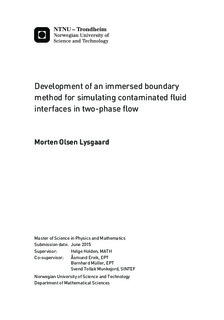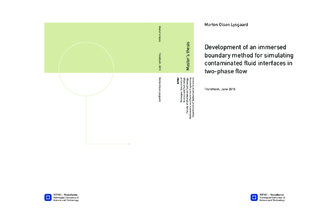| dc.description.abstract | This thesis covers the theory and implementation, verification and validation of an immersed boundary method for simulating the effect of an elastic membrane covering water drops in crude oil. First an introduction to incompressible two phase flow is given. Surface tension as well as elastic effects on the interface are also outlined. The discretization of the Navier-Stokes equations in space and time as well as the projection method are discussed. The penalization method for simulating obstacles in the computational domain is covered, as well as the level-set method for interface capturing, and the ghost-fluid method for handling the interface discontinuities. A thorough derivation of the immersed boundary method is done, and the details of the implementation is covered. A technique for coupling the immersed boundary method and the ghost fluid method is presented, as well as a final overview connecting together all the techniques used in the simulations into one coherent method. Numerical evidence showing that the advection of the immersed boundary method is second order accurate in space is presented as well as numerical results showing that the immersed boundary method in some cases handles advection of the interface in a more accurate way than level-set. Numerical results comparing the immersed boundary method with the ghost-fluid method using the level-set method is presented, showing convergence of the two methods under grid refinement. Numerical comparison between the immersed boundary method and the ghost-fluid method using the level-set method for density and viscosity jumps is done showing consistent results. Simulations of drops with elastic membrane are performed, showing how the immersed boundary method enables the simulation of a larger set of physics than the previous method. The effect of the elastic membrane on a drop stretched in an electric field is simulated. Finally, crumpling of a drop interface is shown as mass is drained from the drop, similar to results seen in lab experiments. | |

